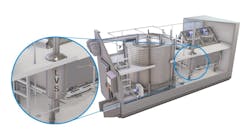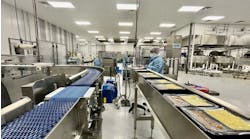When it comes to progress, refrigeration and freezing systems have a certain inertia. They’re big and expensive, and they run according to long-established principles of mechanics, chemistry and physics. All of that works against sweeping innovation.
But improvements are gradually taking hold – snowballing, if you will. Some of these are unique to chilling; others are general trends in all kinds of processing equipment.
Among the latter is increasing interest by end users in sanitary design. For a long time, efficiency, in both capital costs and operation, was the top priority. But now, material choice and design increasingly are being dictated by food safety considerations, especially sanitation.
“I’d say definitely the food safety side has taken precedence over anything else in the past two years,” says Mike Anderson, sales manager for Air Management Technology (www.airmanagement.com), a design-build firm for thermal process supporting solutions.
Sanitation is linked to both food safety and efficiency, says Torbjörn Persson, director of sales for spiral freezers at JBT Corp. (www.jbtc.com/foodtech), whose brands include Frigoscandia and Northfield.
“Food safety becomes visible through higher demands on hygienic design and on more efficient and safe cleaning systems,” Persson says. “When it comes to efficiency, we see that increased demand on longer continuous operating times and in shorter turnaround times, which usually is about making the cleaning cycle as efficient as possible.”
The drive for sanitation is partly a matter of designing equipment for easy cleaning, according to principles that have been established for all kinds of food plant machinery: no sharp corners or creases, no protrusions like bolt heads – basically, no places where dirt, product residue or other contamination could accumulate.
Another aspect is a little more problematic: choice of materials. For blast freezers, especially large boxes like spiral freezers, galvanized steel and aluminum was the most common material for the refrigeration equipment, along with insulated metal panel wall construction, because it delivered the required performance for relatively low cost. But Anderson says with strict food safety requirements, users are increasing requests for all-stainless components, which can better withstand harsher sanitation chemicals.
“The challenge is trying to fit the return on investment with all these enhancements, because [customer] still want to pay the same amount as they did when it was made of galvanized materials,” Anderson says. “Food processors understand the greatly extended equipment lifespan and food safety enhancements stainless offers. The challenge is to minimize additional capital investment.”
The extra expense comes in two ways: most all-stainless refrigeration equipment is custom-made compared to “off the shelf” galvanized components, and stainless steel is just more expensive than galvanized.
One of the biggest challenges in freezer sanitation is getting the inside completely dry before bringing the temperature back down. Because freezers are almost totally enclosed boxes, drying them out is difficult, even with powerful fans.
The QuickDry system from JBT uses hot gas to de-ice evaporator coils for faster, easier cleaning.
“Drying has typically been done by running fans at high speed, much like a dishwasher,” Persson says. “But then, the problem is – much like a dishwasher – if you don’t open the door, it never really gets dry because it’s hard to get rid of all the moisture. And what happens is you end up with a very warm freezer that takes a long time to chill down, and you still have a lot of moisture in there.”
To alleviate this, JBT has developed the LVS QuickDry. It attacks the central part of the problem: moisture freezing on the evaporator coils, the coldest component in the freezer.
“The LVS QuickDry condensates the moisture to the evaporator before heating it again quickly using hot gas, so the moisture that has frozen to the evaporator drips down to the floor,” Persson says. “This gets most of the moisture out of the freezer as quickly as possible.”
Refrigerant choices
Another potential safety issue has to do with choice of refrigerant. For a long time, ammonia was king, and it still is. Ammonia is cheap, reliable and doesn’t harm the ozone layer or otherwise contribute to global warming – unlike a major alternative, R22, which is being phased out. After Jan. 1, 2020, it will be illegal to produce or import R22 in the U.S.
The problem with ammonia is that, while it doesn’t cause global warming, it can be dangerous. It's highly toxic, so leaks in a refrigeration system potentially can be lethal. This is why it’s allowed only in industrial systems, which, at least in theory, have the necessary monitors and alarms. Nine incidents of industrial workers coming into contact with ammonia were reported to the Occupational Health and Safety Administration in 2017, with results ranging from no injuries to second-degree burns.
One way to lower the chance of ammonia exposure is to limit it by using ammonia in conjunction with a more benign refrigerant, like carbon dioxide. This is done in what’s called a cascade system, which is basically a two-part refrigeration setup. The ammonia cools the carbon dioxide during the condensation phase of its refrigeration cycle; the CO2 then enters the evaporator coils, which it chills to generate cold air from adjacent fans. This setup confines the ammonia to the inner works of the refrigeration system, away from people and products. It also can handle lower temperatures than an ammonia-only system.
“Ammonia is still there, it’s just reduced in quantity dramatically. In certain cases the lower the temperature, the better CO2 does compared to ammonia,” says Randy Peterson, senior project developer with the Stellar Group (www.stellar.net).
Because carbon dioxide is denser than ammonia, cascade systems need pipes and pumps that, in most cases, are smaller in diameter than what would be found in an ammonia-only system. That’s why cascade systems are most likely to be original systems, built for new plants; retrofitting would be a costly proposition, Peterson says.
“Unless you’re driven by a court order or a consent decree where you have to do something, it makes no financial sense to retrofit,” he says.
In any case, Peterson firmly rejects the notion that ammonia systems are inherently dangerous. “My position on the topic of safety with any fluid, let alone it being a refrigerant, is it can be handled safely if the system is properly designed and all the rules are followed,” he says. “Any fluid you use can be dangerous. And any fluid you use can be safe.”
Storage savings
The actual system – coils, condensers and whatnot – are not the only places to find innovation in refrigeration. One company is accomplishing it with an embellishment to cold storage spaces that can reduce energy costs by 35 percent or more.
Viking Cold Solutions (www.vikingcold.com) markets a system based on what it calls Phase Change Material (PCM), stored in long, thin cells that usually reside at the top of shelves in a cold-storage area. The material, a mixture of water and inorganic salts formulated to each area’s particular temperature requirements, freezes and retains cold that, when blowers move air over it, helps chill the room. By freezing the cells strategically, the system can get a “cold boost” that reduces energy consumption during peak cost periods.
Viking Cold Solutions furnishes a control system, usually a combination of software and hardware, that can hook into the cold storage area’s existing system and give “suggestions” for peak performance, says Damon Vance, director of marketing.
“Our system makes recommendations to the existing controls,” Vance says. “Basically, it’s making those decisions moment-to-moment based on a number of different factors,” such as air temperature, expected temperature and utility rate structure.
Cryogens
Mechanical refrigeration is one of the two major alternatives available to food processors; the other is cryogenic refrigeration. The latter has higher operational costs, but significantly lower capital costs, as well as more versatility.
Not only can cryogens chill finished product or packages, they can be incorporated into production processes. According to Chris Johnson, business development director at Praxair (www.praxair.com), possibilities include injecting liquid nitrogen or carbon dioxide into a pneumatic powder pipeline as a way to control dough or mix temperatures; injecting them into a batch or continuous mixing vessel; or directly injecting them into product, via setups like bowl chopper injection for mass cooling, auger injection for conveyor cooling and grinder or chopper injection to offset mechanical heat.
Cryogenic freezing can be done in-line for lower capital costs than mechanical. Photo: Linde
Linde LLC (www.linde.com) recently introduced SmartChill, a control system for cryogens being injected into products like ground meat. SmartChill automatically matches the ratio of the liquid cryogen to the food in the grinder or mixer and compensates for pressure fluctuations in the line feeding the cryogen for more consistent temperature control.
One of the problems associated with bottom injection of cryogens is clogged nozzles. Linde solves that through the Lixshooter injector, which features a plunger that can close the aperture when not in use. This seemingly simple feature keeps maintenance personnel from having to routinely disassemble and unclog the dozen or so nozzles in each cooling and blending vessel, greatly saving on maintenance costs.
Chilling systems have been governed by the same basic principles since the development of mechanical refrigeration. But embellishments are available that can contribute to efficiency, safety and the bottom line.


